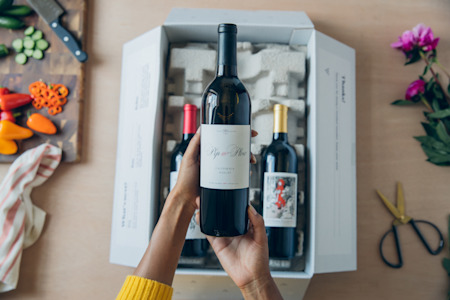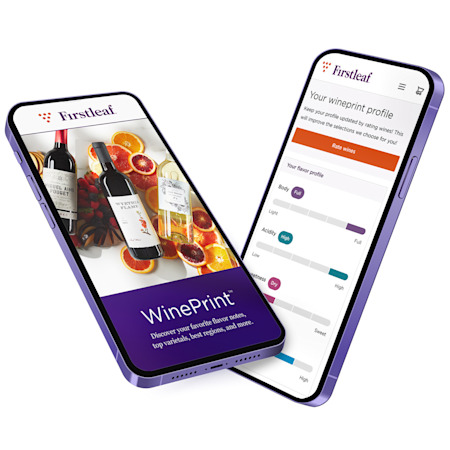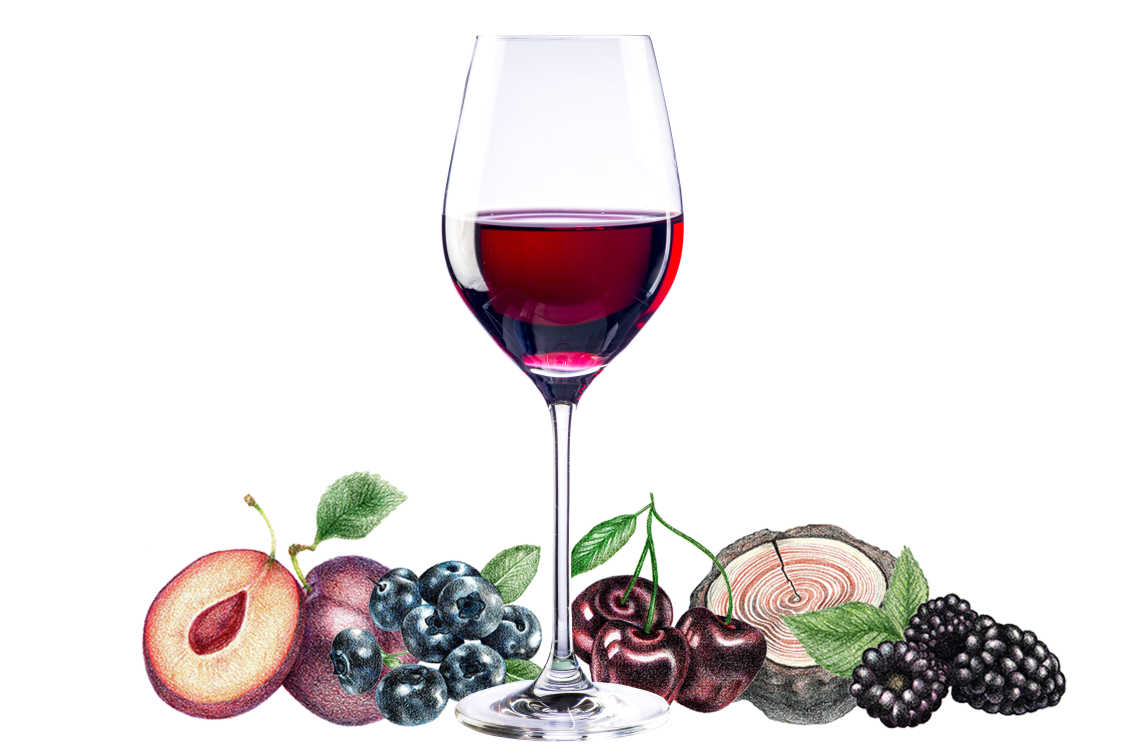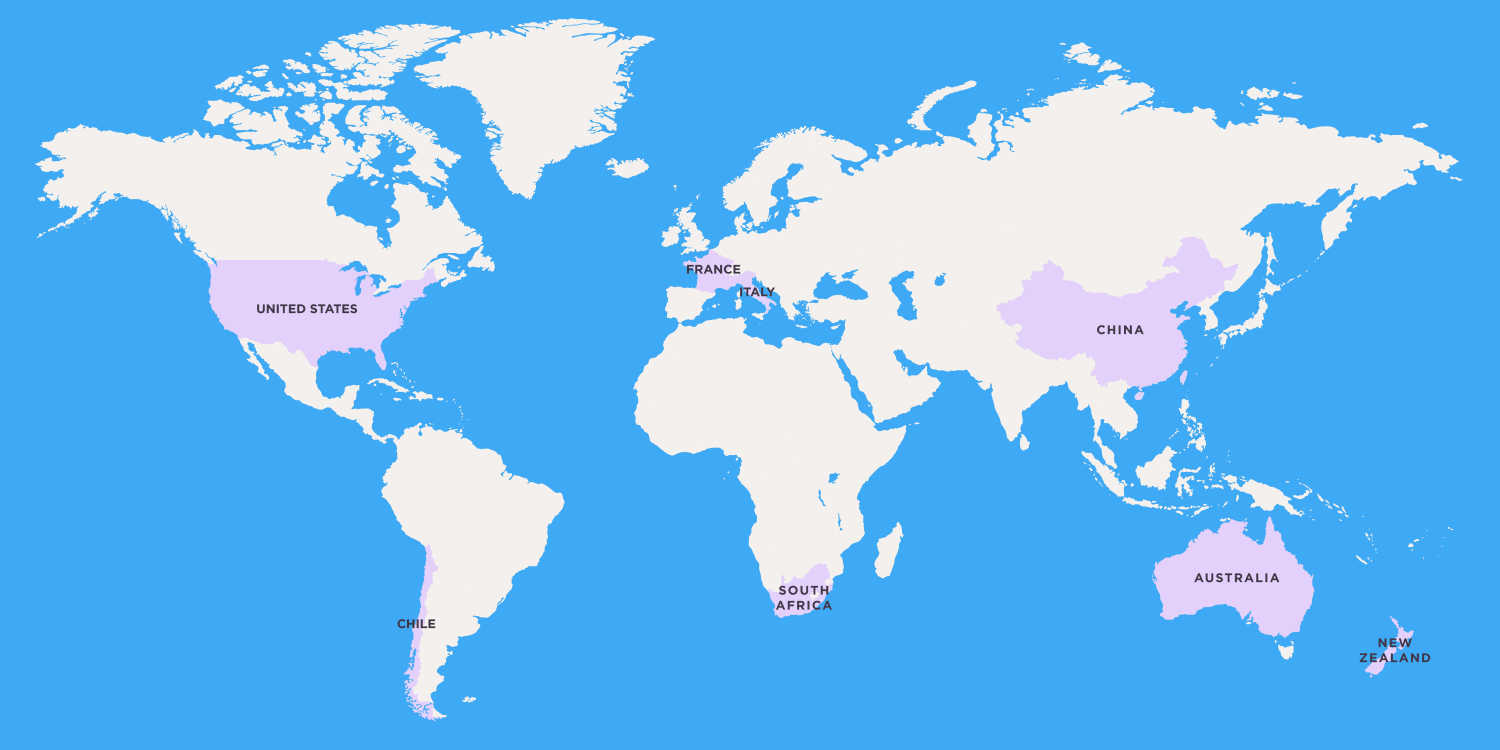Merlot
Merlot is one of the most popular grapes in the world and makes easily approachable, delicious wines
Merlot is a dark blue grape variety that is known worldwide for its plump fruit that can ripen in almost any climate. Used to make red wine, the big berries and thin skins mean that Merlot wines are typically less tannic, more opulent, and ready for consumption long before its closest competitor: Cabernet Sauvignon.
Despite the bad rap in the movie Sideways, Merlot is still one of the most popular red wine grapes in the world. With over 650,000 acres planted across the globe, this international grape comes in on most lists as the second most grown wine grape just behind Cabernet Sauvignon. Winemakers love it because it can grow anywhere (even in damp, cooler climates), it doesn’t need much sun, and it produces large amounts of earthy grapes. It’s soft, easy, and mild and can be made to suit the winemaker’s style. Consumers love it because it is easy drinking with a distinct ripeness of flavor but smooth mouthfeel.

Take Our Quiz Today
Get award-winning delicious wines from all over the world shipped straight to your door. Take the quiz to get the perfect pairings for your holiday season.
Take The Quiz TodayIN THIS ARTICLE:
Want personalized wines?
Get your first box of wines for $44.95 + free shipping.

History of Merlot
Merlot (pronounced mur * low) berries are so dark that they look black. Its name is even a play on the color and is a diminutive of French word merle (little blackbird). This international varietal also goes by the names Picard and Langon.
Originating in Bordeaux, the first official mention of Merlot was in 1784 when French wine officials noted how good Merlot from the Right Bank was. Within 75 years it was planted throughout the left and right banks of Bordeaux. From there it quickly spread. It was documented in Italy in the mid-1800s, Switzerland in the early 1900s, and the rest of the world throughout the 20th century.
Merlot is truly an international grape, and it comes in many different styles. “Old World” Merlot (especially Merlot from locations like Saint Émilion and Pomerol) is incredibly complex and takes time to develop and mature. Conversely, “New World” Merlots are often grown in warmer climates which brings out more of the plummy, fruity characteristics. These require little to no aging and are usually ready to drink as soon as you buy them.
Fun Fact
While it is rare, some parts of Switzerland are known for producing rosé using Merlot, and in Ticino, Switzerland Merlot represents 85% of the grapes planted.
What does Merlot taste like?
Merlot made in the “International Style” (largely New World wines) is harvested late to emphasize bigger, fruitier flavors with a medium to full body. The resulting wines are low in acid and high in alcohol with a soft mouthfeel, velvety tannins, and dark fruit flavors like blackberry, blueberry, black cherry, cassis, and plum.
Old World Merlot (Bordeaux) is picked earlier to showcase a more balanced wine. These wines tend to be higher in acid and have lower alcohol contents that result in a more balanced mouthfeel. They showcase red fruits like raspberry, strawberry, and cherry with the occasional “green” vegetal note.
Merlot Characteristics
Merlot is known for its easy ripening and ability to showcase whatever style a winemaker wishes to pursue. It really is a blank canvas for aspiring winemakers, but one of the most pleasing aspects of Merlot wines is the velvety texture. This texture is sought after by fans of the grape, especially in wines made in the New World style.
Fun Fact
Chateau Petrus is famous for using 100% Merlot grapes on its Pomerol vineyards.
Merlot Nutritional Facts
The nutritional values in Merlot vary greatly depending on two main factors: alcohol and sugar. The more sugar present in a wine, the more carbohydrates.
Some Merlot is sweet, some Merlot is dry and the alcohol can vary greatly depending on how ripe the grapes were when harvested, if the winemaker added extra sugar, and how long it was allowed to ferment. Merlot is generally a medium to medium-high alcohol wine.
How to Serve and Store Merlot
Serving Merlot can be done simply. The wine should be opened and allowed to breathe. Enjoy at a temperature between cellar and room temperature. If you want to experience the wine through multiple stages we recommend popping the bottle of Merlot in the refrigerator for 15 to 30 minutes before serving, but this is all personal preference. Enjoy your wine how you like it.
Once your wine is lightly cooled it is time to open the bottle. Most likely you will need a standard corkscrew, but if you have a particularly old bottle of wine, you might prefer to use a two-prong cork puller.
Merlot does not typically need to be decanted, but if you are drinking an older bottle or one that is particularly complex you should consider decanting it before serving in standard wine glasses.
Merlot should be stored in a cool place that does not receive direct sunlight, and preferably in wine refrigerator or cellar. 55 degrees Fahrenheit is the median temperature wine should be stored if you wish to age the bottles. What matters most is consistency. Do not store your Merlot in a place that receives direct sunlight, heat, or too much humidity.
Fun Fact
"Super Tuscan" wines feature Merlot alongside Cabernet Sauvignon, Cabernet Franc, Syrah, and the native Sangiovese.
What to Pair with Merlot - Best Food Pairings
Pairing wine has some general rules, but we think the most important rule is to drink Merlot with the food you like. If you are looking for specific suggestions for food pairings with Merlot, we would suggest trying it with roasted chicken, lamb, or steak to complement the medium to full-bodied profile.
Merlot wine regions around the world
Merlot is truly an international grape. Here is a brief overview of where it is growing.
France:
The birthplace of Merlot is Bordeaux, and naturally, it is still very prevalent there. St. Emilion and Pomerol, in particular, celebrate the grape and produce some of the finest wines on earth. Outside of Bordeaux, it thrives in Provence, Languedoc, Ardèche, Drôme, Loire, and Savoie.
Italy:
Even with its long history in Italy, Merlot has to compete with native Italian varietals. Merlot plantings grew rapidly through the country with the rise of the "international style" of winemaking in the 70s and 80s. By the mid 90’s it was the 5th most planted grape, and today it is the 4th, even ahead of Barbera. It is planted throughout the Veneto, Trentino, and Alto Adige, but the best Italian Merlots come from Friuli, Tuscany, and Umbria.
Other European Merlot:
Merlot is cropping up all over Europe. There are experimental Merlot vineyard in Rioja, Switzerland, and Spain, but it can also be found in Slovenia, Croatia, Austria, Germany, Romania, Bulgaria, and other parts of Eastern Europe.
United States:
California is the world’s 4th largest producer of Merlot after the Bordeaux region, Italy, and the Languedoc. Cooler spots that don’t suit Cabernet Sauvignon are being chosen for Merlot, but more popular places like Carneros and parts of Napa Valley (Oakville and Stag’s Leap) produce rich Merlot wines. The hillside of Howell Mountain is noted for producing structured and delicious examples. Big, bold, fruity Merlot comes from Mendocino, the Alexander Valley, and Sonoma. Lighter Merlots can be found all throughout the Central Valley of California.
Washington Merlots are fresh, with rich texture and more personality than California Merlots. Cabernet Sauvignon is still the leading red grape in Washington State but Merlot is a close second.
South America:
Chilean Merlot has its own saga. In the 1990s the nature of the Chilean Merlot grapes was questioned because the wines they were producing were less aromatic than expected. It turned out that their Merlot was actually a field blend of Carménère and Merlot. Today it has been sorted and you can find varietal only Merlots, but some of the best wines still get a boost of extra complexity from the Carménère.
Fun Fact
There are farmers in Argentina growing Merlot at over 10,000 feet above sea level.
Australia:
For a long time, Shiraz and Cabernet Sauvignon dominated the Australian wine scene, but Merlot has started to be taken more seriously. It is the 3rd most planted grape in the country, but still substantially behind Australia's two favorite grapes.
New Zealand:
Merlot is known for producing grapes that reach full ripeness even in cold climates. So it is no surprise that it grows very well on the North Island of New Zealand.
South Africa:
No Merlot was planted in South Africa until the 1980s, but we are starting to see interesting wines coming from the premium regions.
China:
The Chinese wine market is growing and will soon become the largest in the world. Red Bordeaux blends are massively popular and have led to the rise of Cabernet Sauvignon, Merlot, and Cabernet Franc across the country.
IN THIS ARTICLE
Want personalized wines?
Get your first box of wines for $44.95 + free shipping.


WinePrint™ by Firstleaf
Are you looking to learn more about your wine preferences? Check out our Wine Print for an in-depth look at your personal tasting profile. Discover your favorite wines, varietals, regions, and tasting notes and get personalized recommendations wherever you are.
Learn More
